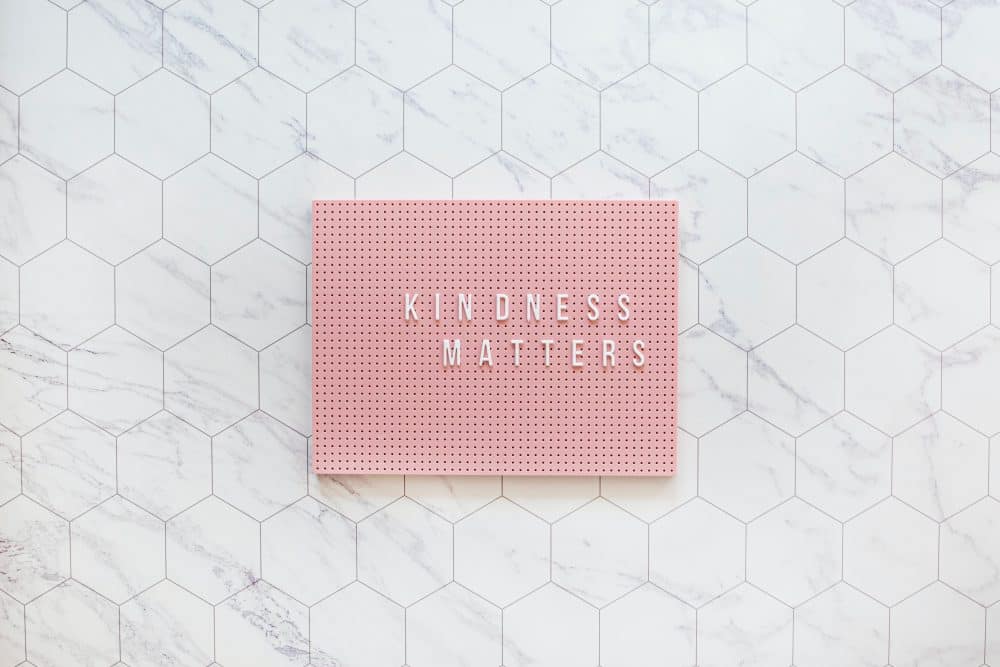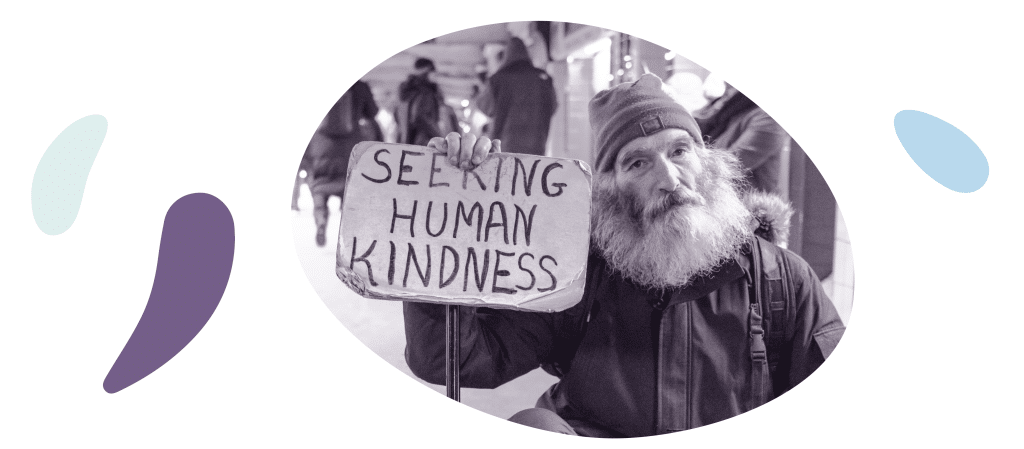Be Kind to One Another: Attachment, Compassion, & Altruism

Published on February 1, 2022 Updated on April 6, 2023
Altruistic behavior is vital to a well-working society. Over the course of our lives, we have many opportunities to do good, help others, and give to those less fortunate. Moreover, our social lives are greatly shaped by our ability to be kind to one another. And just as with almost any other social aspect of our lives, our attachment styles do matter. Here’s how.

We’re taught from a young age to believe that only the most self-serving and successful of us will thrive in the competitive environments that we develop in. After all, Darwin’s most famous quote from On the Origin of Species claimed that only the fittest of us will survive; implying that we need to be selfish in order to flourish and reproduce.
Yet, Darwin – an expert in human evolution – didn’t see humankind as innately selfish. Instead, he believed that we instinctively want to be kind to one another. However, despite the fact that we are more than likely inherently kind, it is not unreasonable to presume that our attachment style influences how this trait develops.
This influence is due to our attachment styles’ profound effects on how we act towards others. A secure attachment can make us more empathetic, more cooperative, and more supportive towards our loved ones. Thus, our ability to be kind to one another undoubtedly has an acute outcome on our relationships, our lives, and society as a whole.
For this reason, in this article we will discuss:
- What are compassion and altruism?
- Why do we need to be kind to one another?
- What is the difference between compassion and altruism?
- How attachment influences compassion and altruism?
- Why does secure attachment facilitate kindness?
- Is it possible to become more compassionate and altruistic?
What Are Compassion and Altruism?
Being compassionate and altruistic means showing concern for the misfortunes of others and being invested in their wellbeing.
Compassion and altruism are two very similar concepts that generally describe how benevolent we are towards others. The former refers to how much we “feel for others” and share their emotional pain. The latter refers to the act of helping those in distress. They are two faces of the same coin, and they’re both influenced by our attachment styles [1,2].
How Attachment Influences Compassion and Altruism
Our ability to be kind to one another is strongly related to our attachment styles. Here’s how:
#1. Attachment influences our ability to tolerate and seek emotional closeness

Strong and close relationships in childhood facilitate the development of secure attachment in children. Later on, a secure attachment enables these children to become emotionally healthy individuals capable of forming and maintaining strong connections with others. Attachment security helps people to feel more comfortable with being close to others. Thus, they are more likely to provide comfort and help to others in need [1].
On the other hand, relationships with caregivers which could be considered conflicting or inconsistent can result in an insecure attachment style. Insecure attachers may find it difficult to be empathetic and kind to one another as they didn’t experience the emotional proximity they needed during their formative years.
#2. Attachment insecurity can maladaptively influence our social support skills
Compassion is a product of specific strategies that we put in place when we have to provide care or support to people that are completely or partially dependent on us [3].
Attachment insecurity interferes with these strategies and that could make it difficult for insecure attachers to be kind to one another. They might struggle to provide effective care and support to others, as well as be emphatic towards other people’s suffering.
#3. Both attachment anxiety and avoidance can hinder compassion
Differences in attachment can be measured along two dimensions: anxiety and avoidance.
Yet, both of these dimensions are related to our ability to be kind to one another. People who display high levels of anxious and avoidant attachment behaviors tend to be less compassionate and altruistic in situations that typically require these traits. What’s more, they often experience an increase in personal distress during these situations [1].
Insecure attachment is typically accompanied by high levels of self-doubt, which can interfere with the helpfulness of their well-intentioned support. People with avoidant attachment are often too defensive and emotionally detached to display much-needed sensitivity towards their partners. Anxious attachers, on the other hand, second-guess themselves so much that it usually leads to scattered and unproductive support [4].
To recap, the two dimensions of attachment (anxious and avoidant) are highly important in determining someone’s attitude towards empathy and compassion:
- High avoidance makes it more difficult to show empathy and to imagine oneself “in another person’s shoes”. This makes people less likely to help and more likely to see generosity towards others as a burden.
- Anxiety generally implies higher levels of empathy compared to avoidant attachers, but people with high anxiety may struggle with providing effective help because they feel overwhelmed by the situation [4].
Do you struggle with attachment anxiety or avoidance? Or maybe both?
Take our free quiz and find out in just 5 minutes!
Does Secure Attachment Help Us Be Kind to One Another?
A secure attachment is integral to our ability to provide effective care, especially towards the people close to us.
People with secure attachment provide support to their partners in times of distress. Also, secure attachers are usually more comfortable than insecure attachers in a range of situations that require support and care towards others:
#1. Attachment security leads to better support and care of a sick or stressed partner.
In anxious attachers, the care provided may be almost compulsive and overly focused on themselves and their need to be seen as a good person. On the other hand, avoidant attachers typically provide less comfort and less quality care – however, this isn’t to suggest that they don’t care, they may just struggle with expressing it [5].
#2. Secure attachers are better at showing empathy towards the suffering of other people.

When confronted by someone in need, securely attached individuals are more likely to provide comfort, even if the person is a stranger [6]. The help they provide tends to be highly effective, as secure people are skilled at recognizing other people’s emotions and acting accordingly [5].
Moreover, they are also likely to make personal sacrifices to help others, volunteer in their communities, and have altruistic reasons for doing so [3]. In comparison, anxious attachers may struggle to help others without becoming too distressed to be effective. Furthermore, avoidant attachers might be uncomfortable with others needing them and, thus, show lower levels of compassion [5].
#3. People with secure attachment are also skilled in cooperative situations.
Secure attachers are more likely to interact with others and feel less threatened by other people’s disagreements. They also tend to act less discriminatorily towards members of other groups than someone with an insecure attachment. Interestingly, a secure attachment has even been proven to reduce differences between groups, even in complex settings, like interactions between Arab and Israeli populations [3].
Can We Train Ourselves to Be Kind to One Another?
Acting more compassionate and altruistic is a helpful way of improving mental health and developing secure attachment [7]. But how can we learn to be more helpful to others?

Considering its influence on wellbeing, mental health, and quality of life, researchers are trying to find ways to evoke compassion. Here are some suggestions based on the latest research:
- Think of a time when someone showed you kindness or when you were kind to others. Research shows that thinking about times when you performed or were the target of a kind, compassionate action can help decrease anxiety and make you feel more relaxed [8].
- Find ways to volunteer and give back to others. Participating in activities that involve showing compassion towards others can make you feel better, and also increase your attachment security, making you even more compassionate and altruistic in the future! [3].
- Seek the help of a professional. Therapy can assist you in figuring out your attachment style and how it influences your relationships with others. A trained therapist can also help by making you think of others and their struggles with more kindness. Research shows this can have positive effects on depression, anxiety, and even some forms of pain [9].
Take-Home Message
Be kind to one another: it only makes our lives and our social relations more secure and open. A lack of altruism and compassion, on the other hand, can create difficulties in our social lives.
If you are aware that you have a hard time showing compassion and empathy towards others, try one of our suggestions above. Think of a time when someone was kind to you, or an occasion when you did something good for others. Find a local or online volunteer group to join, or – if you need it – get in touch with a mental health professional; a therapist can help you uncover hidden mechanisms that influence your ability to show compassion. Many therapies are even performed online and are proven to work between different cultures [10].
Our attachment styles influence various aspects of our social lives.
Interested to learn more?
Keep exploring our blog and follow us on social media!
References

[1] Mikulincer, M., Shaver, P. R., Gillath, O., & Nitzberg, R. A. (2005). Attachment, caregiving, and altruism: Boosting attachment security increases compassion and helping. Journal of Personality and Social Psychology, 89(5), 817–839.
[2] Richman, S. B., DeWall, C. N., & Wolff, M. N. (2015). Avoiding affection, avoiding altruism: Why is avoidant attachment related to less helping? Personality and Individual Differences, 76, 193–197.
[3] Mikulincer, M., & Shaver, P. R. (2005). Attachment security, compassion, and altruism. Current Directions in Psychological Science, 14(1), 34–38.
[4] Mikulincer, M., & Shaver, P. R. (2017). Adult Attachment and Compassion: Normative and Individual Difference Components. In E. M. Seppälä, E. Simon-Thomas, S. L. Brown, M. C. Worline, C. D. Cameron, & J. R. Doty (Eds.), The Oxford Handbook of Compassion Science (pp. 79–89). Oxford University Press.
[5] Shaver, P. R., Mikulincer, M., Sahdra, B., & Gross, J. (2016). Attachment Security as a Foundation for Kindness Toward Self and Others. In K. W. Brown & M. R. Leary (Eds.), The Oxford Handbook of Hypo-egoic Phenomena. Oxford University Press.
[6] Campbell, K., & Ramos, S. (2017). Enhancing Student Altruism Using Secure Attachment Messages (SAM) in Lecture. Journal of the Scholarship of Teaching and Learning, 17(4), 95–103.
[7] Raque-Bogdan, T. L., Ericson, S. K., Jackson, J., Martin, H. M., & Bryan, N. A. (2011). Attachment and Mental and Physical Health: Self-Compassion and Mattering as Mediators. Journal of Counseling Psychology, 58(2), 272–278.
[8] Kirschner, H., Kuyken, W., Wright, K., Roberts, H., Brejcha, C., & Karl, A. (2019). Soothing Your Heart and Feeling Connected: A New Experimental Paradigm to Study the Benefits of Self-Compassion. Clinical Psychological Science, 7(3), 545–565.
[9] Navarro-Gil, M., Lopez-del-Hoyo, Y., Modrego-Alarcón, M., Montero-Marin, J., Van Gordon, W., Shonin, E., & Garcia-Campayo, J. (2020). Effects of Attachment-Based Compassion Therapy (ABCT) on Self-compassion and Attachment Style in Healthy People. Mindfulness, 11(1), 51–62. [10] Campos, D., Navarro-Gil, M., Herrera-Mercadal, P., Martínez-García, L., Cebolla, A., Borao, L., López-Del-Hoyo, Y., Castilla, D., Río, E. del, García-Campayo, J., & Quero, S. (2020). Feasibility of the internet attachment⇓based compassion therapy in the general population: protocol for an open-label uncontrolled pilot trial. JMIR Research Protocols, 9(8).











 Get mental health tips straight to your inbox
Get mental health tips straight to your inbox








